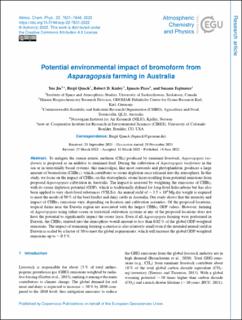| dc.contributor.author | Jia, Yue | |
| dc.contributor.author | Quack, Birgit | |
| dc.contributor.author | Kinley, Robert D. | |
| dc.contributor.author | Pisso, Ignacio | |
| dc.contributor.author | Tegtmeier, Susann | |
| dc.date.accessioned | 2022-07-05T08:04:04Z | |
| dc.date.available | 2022-07-05T08:04:04Z | |
| dc.date.created | 2022-07-04T08:40:01Z | |
| dc.date.issued | 2022 | |
| dc.identifier.citation | Atmospheric Chemistry and Physics (ACP). 2022, 22, 7631-7646. | en_US |
| dc.identifier.issn | 1680-7316 | |
| dc.identifier.uri | https://hdl.handle.net/11250/3002691 | |
| dc.description.abstract | To mitigate the rumen enteric methane (CH4) produced by ruminant livestock, Asparagopsis taxiformis is proposed as an additive to ruminant feed. During the cultivation of Asparagopsis taxiformis in the sea or in terrestrially based systems, this macroalgae, like most seaweeds and phytoplankton, produces a large amount of bromoform (CHBr3), which contributes to ozone depletion once released into the atmosphere. In this study, we focus on the impact of CHBr3 on the stratospheric ozone layer resulting from potential emissions from proposed Asparagopsis cultivation in Australia. The impact is assessed by weighting the emissions of CHBr3 with its ozone depletion potential (ODP), which is traditionally defined for long-lived halocarbons but has also been applied to very short-lived substances (VSLSs). An annual yield of ∼3.5 × 104 Mg dry weight is required to meet the needs of 50 % of the beef feedlot and dairy cattle in Australia. Our study shows that the intensity and impact of CHBr3 emissions vary, depending on location and cultivation scenarios. Of the proposed locations, tropical farms near the Darwin region are associated with the largest CHBr3 ODP values. However, farming of Asparagopsis using either ocean or terrestrial cultivation systems at any of the proposed locations does not have the potential to significantly impact the ozone layer. Even if all Asparagopsis farming were performed in Darwin, the CHBr3 emitted into the atmosphere would amount to less than 0.02 % of the global ODP-weighted emissions. The impact of remaining farming scenarios is also relatively small even if the intended annual yield in Darwin is scaled by a factor of 30 to meet the global requirements, which will increase the global ODP-weighted emissions up to ∼0.5 %. | en_US |
| dc.description.abstract | Potential environmental impact of bromoform from Asparagopsis farming in Australia | en_US |
| dc.language.iso | eng | en_US |
| dc.rights | Navngivelse 4.0 Internasjonal | * |
| dc.rights.uri | http://creativecommons.org/licenses/by/4.0/deed.no | * |
| dc.title | Potential environmental impact of bromoform from Asparagopsis farming in Australia | en_US |
| dc.title.alternative | Potential environmental impact of bromoform from Asparagopsis farming in Australia | en_US |
| dc.type | Peer reviewed | en_US |
| dc.type | Journal article | en_US |
| dc.description.version | publishedVersion | en_US |
| dc.rights.holder | © Author(s) 2022. | en_US |
| dc.source.pagenumber | 7631-7646 | en_US |
| dc.source.volume | 22 | en_US |
| dc.source.journal | Atmospheric Chemistry and Physics (ACP) | en_US |
| dc.identifier.doi | 10.5194/acp-22-7631-2022 | |
| dc.identifier.cristin | 2036931 | |
| cristin.ispublished | true | |
| cristin.fulltext | original | |
| cristin.qualitycode | 2 | |

